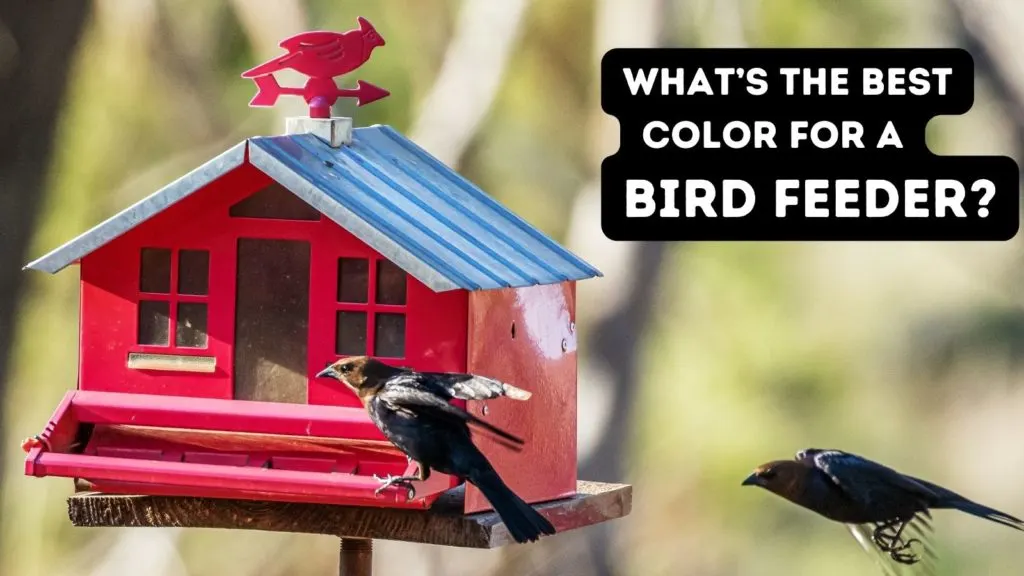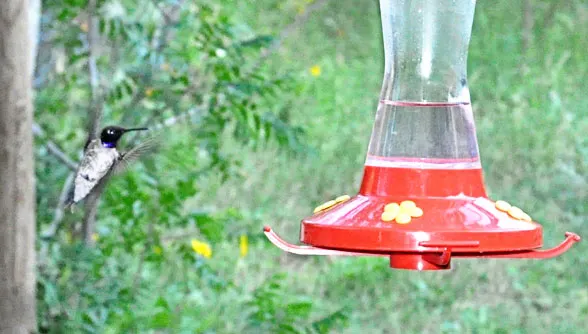Choosing the right color for your bird feeder can make a significant difference in how many feathered friends you’ll have visiting your garden. Birds are attracted to certain colors based on visibility and association with food sources. Just like a brightly colored flower can attract pollinators, certain colored feeders are more appealing to birds. Let’s look at how your choice in color might not only bring more birds to your yard but can also cater to specific species you’re aiming to attract. (And how one color might drive AWAY birds you are wanting to attract!)

The Most Common Bird Feeder Colors
The most commonly attractive colors for bird feeders are red, orange, yellow, and blue. These colors are known to stand out in the natural environment, catching the eye of passing birds–but different colors attract different bird species!
For example, orange has been noted for its effectiveness in attracting orioles while goldfinches show a preference for yellow, a hue that matches their own vibrant coloration and the sunflowers they enjoy.
When selecting a bird feeder, it’s important to consider the color preferences of your local bird population alongside the aesthetic of your garden. A well-chosen color can create a win-win situation, where the birds enjoy a meal and you enjoy watching them in a setting that complements your outdoor space.
Basics of Bird Feeder Colors
When you’re selecting a bird feeder, color is more than just an aesthetic choice—it’s a critical factor that influences which birds you’ll attract to your backyard.
Color Psychology in Birds
Birds use color to navigate their world, and certain colors can influence their behavior. You’ll find, for example, that colors in the high-energy wavelengths such as purple, green, and blue tend to be more appealing to birds because these colors are abundant in their natural environment.
They can also perceive ultraviolet light, adding dimensions to colors that humans can’t see.
Natural Preferences
Birds are drawn to colors that mimic their feeding habits in nature.
Orioles are attracted to orange, possibly because it resembles the fruits they commonly eat. Similarly, a red feeder may attract birds like hummingbirds that are drawn to red flowers.
Also, feeders that are natural colors may appeal to a certain type of birds. Feeders that are green, brown, or gray tend to blend in with the natural environment and may be more attractive to birds seeking a safe feeding place. These colors can be particularly appealing to more cautious species.
Contrast and Visibility
The visibility of a bird feeder can impact how quickly and easily birds can spot their potential food source. Color contrast with the surrounding environment makes a feeder stand out more.
Brightly colored feeders can grab attention, but ensure they don’t blend into brightly colored gardens. Black feeders can provide good contract in some backgrounds and during snowy months.
Popular Bird Feeder Colors
Selecting the right color for your bird feeder can have a significant impact on the types of birds that grace your garden. Here’s what you need to know to make your feeder a hotspot for avian visitors.
Bright Versus Subtle Colors
Your choice between bright and subtle colors can greatly influence bird activity in your yard. Brightly colored feeders may attract birds that are naturally attracted to vibrancy, as they can easily spot these colors from a distance. While a multi-colored feeder could be attractive, focusing on bright and contrasting colors relevant to the bird species you aim to attract is more beneficial.
Conversely, feeders with more subdued hues may blend into the environment, attracting less attention from birds and possibly from predators.
Except for our red hummingbird feeders, at our home we have natural wood colored feeders–but we’ve been feeding birds at these spots for many years so they’re more accustomed to look for the food.
Effect of Red on Birds

The color red has a particular appeal to birds such as hummingbirds. While not all species are drawn to red, hummingbirds associate the color with nectar, making red-colored feeders or those with red accents more inviting to these tiny, fast flyers.
Role of Blue and Green
Blue and green feeders also play their parts. Blue is noted for its summer popularity among some bird species, while green can be a preference for birds like goldfinches. Green hues often mesh well with the natural surroundings, possibly providing a comfortable and secure feeling for visiting birds.
Which Color Should You Avoid?
White can sometimes be seen as a warning color to birds, possibly signaling danger. Feeders in this color might be less attractive to them.
Also, in snowy environments, a white feeder may not stand out as much, so having a darker or vibrantly colored feeder would be more beneficial.
Tips for Choosing Bird Feeder Colors
When selecting a bird feeder, the color can be just as important as the design. The right hues may attract a greater variety of birds to your garden.
Assessing Local Bird Species
Know Your Birds: Research the bird species that are common in your area. Goldfinches are attracted to yellow, while orioles favor orange feeders. Hummingbirds are drawn to red, so if they’re local to you, consider feeders with red elements.
Experimenting with Colors
- Try Different Colors: Start with colors known to attract the birds in your area, then experiment.
- Observe Changes: Take note of bird visit frequency to see which color works best.
- Visibility: Place feeders where they are easily visible against the colors of the background to help birds spot them.
- 8 Letter Bird Names - August 14, 2024
- 7 Letter Bird Names - August 14, 2024
- 7 Birds Named After Famous People - July 23, 2024
